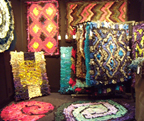Karen Tiede has taken a circuitous route to professional art. The child of a Marine Corps family, she had lived in Germany, Quantico, England, South Africa, the Soviet Union, and Camp Lejeune before college. Her first degree was in chemistry and Russian, from Duke; she added a master’s in Landscape Design from the Conway School of Landscape Design several years later. Until the late 90s, her artistic output had been limited to largely private textiles and somewhat indulgent garden creations, given that she lived in rented property.
She came to the arts community in downtown Moncure after ten years in Chapel Hill, in search of an affordable house, unaware she would find a new vocation. She took an interest in the activities at the Moncure Chessworks across the street and creating her own sculpture seemed like a natural next step. All she needed was a subject, and material.
The gift of a trip to the Ross Sea, Antarctica, in 1999 provided the subject. There were penguins at every landing, and Karen caught a bad case of Ice Fever, falling under the spell of the continent and the birds. She filled five sketchbooks and 42 rolls of film during the trip. Back at home, she tried to paint what she’d seen and couldn’t capture the magic of the birds, or the landscape, on canvas.
Then lightning struck, literally, on Labor Day, 2000. When the smoke cleared and the fire department left, it was clear that the stricken tree had to come down. Unremarked at the time was the effect of being within 20’ of a direct lightning strike. Karen noticed some memory loss and logic processing dysfunction that appeared to clear up in a few weeks. Some years later, a neurosurgeon heard the story and said, “That was electroshock.” Today, Karen is beyond grateful for the geography that allowed for what she now considers a “rewiring,” softening years of left-brain dominance without significant intellectual loss. Five feet closer to or farther from the strike might have resulted in either tragedy, or no change at all. However, she observes that on days when art is flowing, she loses her ability to manage logical word order and sentences come out jumbled.
Karen asked the arborist to take the branches and leave the tree’s trunk, bought a chainsaw with the insurance money, and started carving. Penguin decoys were a natural first choice, given the frustration inherent in trying to paint pictures of the birds. Penguins “fit” in a log. Her decoys convey the individual attitudes and characteristics of several penguins species in a reasonably accurate fashion.
Over the years, her sculpture broadened to include many other subjects, both figurative and abstract. “I wonder what that would look like…” and “that would be fun to carve…” and “how come no-one’s carving that?” are the signal flares that a new carving is about to emerge from the woodpile. Frustration with the physical and technical limits of log sculpture has led Karen to branch out 😉 into log furniture. In addition, she played with other sculptural materials, such as garden hoses, various forms of colored glass, CDs, and coat hangers. Much of this vernacular garden ornament is made for fun and furtherance of the idea that “the more art you make, the more art you can make.” Fortunately, downtown Moncure has no appearance commission setting standards for what can or cannot be displayed, and residents regularly slow down to see what’s new in the garden.
In 2006, following a bout of Rocky Mountain Spotted fever, Karen’s life changed again. For most of the summer, the fever left her unable to carve safely, and she turned to an old love, knitting. Other work and life changes combined to keep her away from chainsaws for a while, and the rugs grew into the vacant space in her creative energy. There are more color options for textiles than wood, and while the finished product is still respectably heavy, she has to admit, it’s easier to move and store textile art than wood carvings!
Karen and her long-time companion John Hogan became engaged in the summer of 2017. She looked at the venue they selected for their wedding, knew it needed more and bigger flowers than she wanted to buy at retail, and she set to work. She made all the flowers for the room, the tables, and the wedding party, and had so much fun, she didn’t stop after they were married in January, 2018. Now she’s making fabric flowers and selling arrangements and bouquets. There will be a new book soon.
(* we pronounce it TEE dee.)

